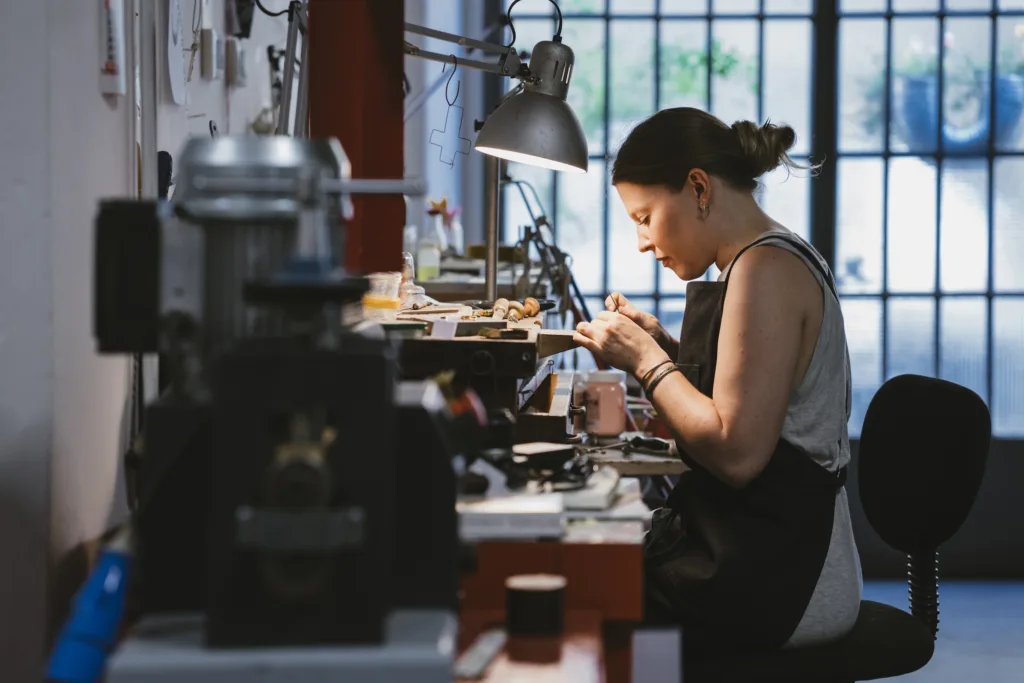As Julie’s online store went live, she was a bundle of nerves and excitement. Her phone buzzed non-stop with notifications of followers engaging with her posts, friends and family congratulating her, and, thrillingly, orders being placed. In this installment, we accompany Julie as she navigates the rush of her first sales, tackles fulfillment challenges, and takes the first steps towards turning her passion into a thriving business.
What have been some of the most valuable resources or pieces of advice that you came across during the initial stages of setting up your business?
I found some cool peeps online, like other crafty moms and stuff. We shared tips and tricks on social media, and that helped a bunch. There’s this book, “The Handmade Marketplace” – kinda became my bible. And talking to customers, they gave me ideas on what they liked. That’s how I came up with them dreamcatcher earrings, which everyone loves!
Julie on seeking advice
A Flood of Orders
Julie hadn’t expected the volume of orders she received in the first 24 hours. While elated, she was also overwhelmed. She worried about managing inventory, packaging, and shipping all the orders on time. The thought of disappointing her new customers was a nightmare.
Julie recognized she needed help, so she asked her friends to assist with packaging the orders. She also set up a designated area in her living room as a temporary packaging station to streamline the process.
She kept an open line of communication with her customers through email and social media, updating them about the status of their orders and thanking them for their support.
For shipping, Julie decided to do daily drop-offs at the local post office to expedite the shipping process. She meticulously checked the addresses and ensured that each package was secure.
Learning from Customer Feedback
Julie received feedback from a few customers about various issues. One customer mentioned that the earring hook was slightly bent upon arrival. Another customer wished for more eco-friendly packaging.

Julie saw this as a prime opportunity not just for improvement, but also for creating a positive customer experience and building her brand image. Here’s how she addressed the issue:
First and foremost, Julie personally reached out to the customers who had received damaged items. She sent them a heartfelt email, in which she apologized for the inconvenience and expressed her gratitude for their support. She assured them that their feedback was invaluable and that she was taking steps to rectify the issue. Julie offered to replace the damaged items for free or provide them with a discount code for their next purchase.
Realizing the importance of sustainable packaging, especially given her audience’s preference for eco-friendly products, Julie spent hours researching different packaging options. She looked into materials like recycled cardboard, paper tape, and biodegradable bubble wrap. She reached out to suppliers and asked for samples to ensure the packaging was both sturdy and aligned with her brand values.
Engaging with the Community
While she was in the process of making the switch, Julie kept her followers in the loop through her social media platforms. She shared stories about her journey to find the right packaging, sometimes even asking for their input on options she was considering. This not only showed transparency but also made her customers feel like they were part of the process.
After she made the switch to eco-friendly packaging, Julie crafted a post in which she thanked the customer who had brought the issue to her attention by tagging them (with their permission). She shared pictures of the new packaging and explained why it was a better choice, not just for the safety of the jewelry but also for the environment.
Julie recognized that the growth of her business depended on continuous improvement. She introduced a feedback form on her website where customers could share their experiences and thoughts. This form was also sent in a follow-up email after purchases. She committed herself to regularly reviewing this feedback and making any necessary adjustments.
This experience taught Julie a crucial lesson in adaptability and the importance of customer feedback. It also helped establish her brand as one that truly cares about both the quality of the products and its impact on the environment. Her proactive approach and genuine communication strengthened her relationship with her customers and garnered respect and loyalty for her brand.
Refining the Business
As the initial rush of orders started to stabilize, Julie took a step back to evaluate her business. She realized that she needed to have a better system in place for inventory management, packaging, and shipping. She also decided to gather all the feedback she received to make her products and services better.
She implemented inventory management software to track her supplies and products. Julie also reached out to local artisans to explore collaborations that would allow her to expand her product range while supporting fellow creatives.
Who’s been the biggest help to you in launch your business?
Haha, my kids, they’re my little assistants. Jaden and Alysha, they love to sit with me when I’m making jewelry. They’ll pick out beads and stuff, and sometimes, they even come up with really cool design ideas. Jaden made this awesome necklace with like, all these earthy colors, and it was a big hit at the last festival. I gotta say, having them around makes the long hours worth it.
As her business begins to take shape, Julie realizes that continuous improvement is the key to success. In the final part of this series, we will see how Julie plans for the future, sets new goals, and continues to build her jewelry design business. Join us for Part 5: Crafting the Future: Join Julie as she lays the groundwork for the growth and sustainability of her business.


